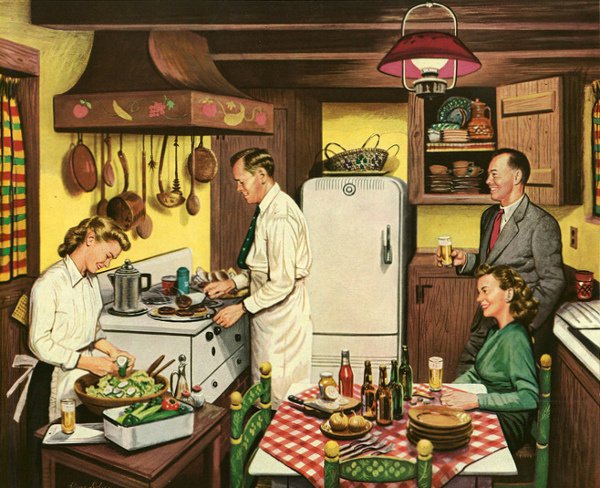
Editor’s note: The following is an excerpt from Brunch Is Hell: How to Save the World by Throwing a Dinner Party by Rico Gagliano and Brendan Francis Newnam. Gagliano and Newnam argue that dinner parties can serve as “the very cornerstone of a healthy modern society.” But what actually constitutes a dinner party? They explain below, as well as in my podcast interview with Newnam.
Before committing yourself to our dinner party blueprint, you should first figure out if the gathering you plan to host is, in fact, a dinner party. Because while the definition of a dinner party may self-evidently seem to be “a party which occurs over dinner,” the truth, as with most things of world-shaking importance, is a little more complex. For example:
- Is it a dinner party if you’re eating at 4 p.m.?
- Is Passover seder a dinner party?
- What if the food is takeout pizza and the booze comes in shiny twelve-ounce pull-tab cans with a contest advertised on the back?
These are all potentially swell gatherings. But none of them are dinner parties, and we’re going to tell you why.
MINIMUM STANDARDS
Below are the internationally recognized standards which define the modern dinner party, as put forth by the UN Nutrition and Reverie Commission’s Subcommittee on Common Sense. A.k.a. us. In ensuing chapters, you’ll see, we advocate a casual disregard for many rules. But a true dinner party must at least adhere to these basic standards for it to qualify for the revolution.
PURPOSE
1. The purpose of throwing a dinner party is to have dinner and to party.
A dinner party must have no agenda other than this. Our lives are already planned enough; the dinner party is a space for spontaneity. It is, as we will remind you several more times throughout the course of this tome, recess for adults. When you were a kid, did you actually plan to get beaten up at recess? No! It just kind of happened. Dinner parties are like that, except instead of randomly getting beaten up, random fun occurs.
TIME
1. Weekday dinner parties must begin after 5 p.m.
A true dinner party begins after the typical workday has ended, i.e., no earlier than 5 p.m. This is so a maximum number of invitees can actually attend.
It’s also because a dinner party should be a celebration of time away from work. Not a burden that forces guests to abandon work early, fight rush hour traffic, and then spend the whole party worrying about the work they didn’t do.
In fact, rule of thumb: Begin the party a half hour later than your town’s typical rush hour ends. So, for instance, in Los Angeles, that’d be about midnight.
2. Weekend dinner parties must also begin after 5 p.m.
This allows enough time for the following:
- For hosts to sleep late, and then clean the bathroom for the party.
- For guests to sleep late, do one chore, and then do something fun, productive, or otherwise excellent for themselves before the party (e.g., hiking, sex, sitting quietly and enjoying trees).
- For guests to buy some booze to bring to the party.
Another reason dinner parties happen after 5 p.m. is because that’s when dinner happens, guys.
3. There is no standard end time for a dinner party.
You’re thinking of children’s parties. Those have end times so parents know when to pick up their kids from your house, with a few hours to spare to get them ready for bed.
A grown-up may also have a bedtime, but the awesome part about being a grown-up is you’re allowed to blow it off. A dinner party is only over when the last guest leaves/drunkenly stumbles into a cab.
3a. HOWEVER, if some or all of your dinner party guests end up sleeping over, then the party officially ends at dawn. In other words, the ensuing gathering the next morning is no longer a dinner party. It is breakfast. With a very real danger (due to the proximity of leftover food and booze) of brunch breaking out. Be on guard.
DAY OF THE WEEK
1. Dinner parties must NOT be held on Sundays, Mondays, or Tuesdays.
You and/or at least some of your guests have to work on Monday. Not even the most magical Sunday night party can make someone forget how much that sucks. Don’t bother trying. (Exception: If Monday is a day off due to a minor holiday (e.g., President’s Day), Sunday can be treated as a “bonus Saturday” and therefore fair game for a dinner party.)
As for Monday nights, they are for doing stuff you thought you’d do over the weekend, but didn’t, because it felt too much like work. Like paying bills, or writing a book about dinner parties.
Tuesday nights are just kind of dumb.
2. Fridays and Saturdays are the optimal nights for a dinner party.
Both Fridays and Saturdays are part of that brief weekend window during which you can trick yourself into thinking you’ve escaped the rat race. Each is also followed by a convenient twenty-four-to-forty-eight-hour hangover/humiliation recovery period.
Be aware, however, that for these very reasons, 50 to 100 percent of your friends will be throwing various types of parties on Friday or Saturday nights. Competition for guests will be fierce. Therefore:
3. Wednesday and Thursday night dinner parties are encouraged.
By Wednesday or Thursday night, it’s been long enough since you’ve been at a party to feel like being at another one. And partying on a “school night” is a great way to celebrate the freedoms of adulthood.
What’s more, a great Wednesday or Thursday night dinner party can effectively “front-load” your weekly allotment of social time. This leaves you Friday and Saturday night to read, relax, or fall down an Instagram hole while everyone else sits in traffic on their way to parties.
4. Holidays
Parties held during the week preceding a major national holiday are not dinner parties. They are holiday parties.
LOCATION
1. For the time being, a dinner party must happen on the planet Earth.
We cannot advocate the consumption of large quantities of wine in the zero gravity environment of the International Space Station.
2. A dinner party must be held at a private residence.
Or a public residence, if your home is the White House. ’Cause, hey, you spent a lot of money in order to live there.
Now then: why a private residence, as opposed to a public spot? Partly because the cops are a lot less likely to intervene if anyone gets loud or naked. But also because welcoming non-family-members into your home is the most civilized of all possible acts. When Thorag invited Grunt over for pterodactyl sous vide, trusting that Grunt would not club him in the face and then eat Thorag’s wife, Lauren — well, that was a big step for mankind. As best-selling author and military documentarian Sebastian Junger once told us on our show,
“Humans are the only species in which a young male (or female, for that matter) . . . will sacrifice his own life defending a peer he is not related to.”
Swap “sacrifice his own life defending” with “give his last piece of roast beef to,” and you’ve got the idea. Being a host to your pals = humanity.
To summarize thus far: A dinner party is a gathering held on Earth, after 5 p.m., Wednesdays through Saturdays, in someone’s home, at which pterodactyl is served. Speaking of which:
FOOD
1. A proportion of the food at a dinner party must be homemade.
Not cooking for your own dinner party is like DJ-ing a dance party with the radio. The point of a dinner party is to revel in unique, gloriously imperfect humanity. Your humanity. Expressing your taste, your style, and your essence, with food you prepared with your own hands, is part of what makes this deal so important.
The preparation of food also serves as the narrative spine of your event: cooking, serving, and cleanup are the three acts of your gathering. Without them, a dinner party is a movie without a plot. That only works for Richard Linklater.
2. The 51 percent rule.
DON’T WORRY. We acknowledge the distractions and pressures of the modern world, where whole seasons of binge-worthy TV shows are released daily, and where your boss can text you work tasks even while you’re in labor. You may not have a ton of extra time to cook a multicourse meal. Therefore, a gathering is a dinner party as long as at least 51 percent of the dishes served are made at home.
This means that yes, you can serve a bunch of killer tamales you ordered from that great Mexican place down the street. But you must additionally prepare a salad and your mother’s special queso recipe. And bake cookies for dessert or something. Also:
3. Hide the packaging.
At a true dinner party, all non-homemade food is removed from its packaging. If you serve the tamales straight out of the giant foil pan in which they were delivered, for instance, that’s not a dinner party, that’s a feeding trough. Just put the tamales on some kind of serving dish, would you? Even piling them up on a dinner plate like a meat-and-masa ziggurat is acceptable.
This rule goes double for food packaging emblazoned with a corporate logo. Remember, dinner parties are a respite from advertising. Your dining room is not a billboard, and your gathering is not a Hollywood blockbuster — this is no time for product placement.
ENVIRONMENT
1. Mandatory table.
For a gathering to qualify as a dinner party, there must be a table present.
1a. The table’s purpose is to force the entire group to converse together; therefore, attendees must actually be seated around it while dining.
2. A dinner party is an A/V‑free zone.
All audiovisual electronic equipment within twenty-five yards of a dinner party must be switched off — except for the minimum amount necessary to play music. The goal is to keep visual distractions to a minimum so the focus is on the humans sitting in front of you.
Thus, your television is subject to the same rule that applies to you when visiting your attractive doctor: It should not be turned on. A Super Bowl viewing party is not a dinner party.
Cell phone usage should be tightly policed. A quick hourly check of mail/messages is cool, but guests attempting to launch YouTube should be denied food/booze and mocked until they desist. Otherwise your dinner party will quickly become a YouTube party.
For the same reason, laptops are verboten unless they are your music source.
Also, disable all Roombas. They’re cute — everyone will look at them.
3. A dinner party can be held outside.
Among the most iconic dinner parties ever is the alfresco gathering in Fellini’s Italian cinema classic 8½. (True, that party had, like, a thousand guests, in clear violation of the four-to-twelve rule (see below). But when you’re among the greatest filmmakers of all time, you can file for an exception.) Indeed, between April and August in many European countries, dinner parties are held indoors only in the event of hail or war. So by all means, set up a table in the backyard! Just take care you’re not accidentally throwing a barbecue, which is a totally different thing.
ATTENDEES
1. The four‑to‑twelve rule.
To qualify as a dinner party, your guest list must include at least four people but no more than twelve. That’s including you, the host.
Two people is just dinner: quiet and comfortable. It’s a pair of friends sharing a meal. It’s you and your spouse catching up after a long day. Add a third person, and there’s a tendency for things to turn into something more like therapy than a party. It’s a sympathetic couple keeping their sad single friend sane. Or three single friends venting about condescending couples.
Four people can comprise a dinner party, unless the attendees are two couples, in which case it’s no longer a dinner party and becomes a double date.
As for a guest list of more than twelve people? You’ll have a hard time fitting them all around one table. It’ll get too loud for everyone to ever share one conversation. And making enough salad for that many guests is going to give your salad-tossing arm carpal tunnel. If your guest list exceeds twelve people, just put out cheese and crackers and call your gathering a plain old party, which is what it is.
2. Family members: The 25 percent rule.
Dinner parties are an essential means of maintaining and cultivating friendships outside your family. Therefore, your gathering is not a dinner party if more than 25 percent of the attendees are your relatives. Family gatherings can be great, but at a dinner party the majority of guests should be there because they choose to be — not because they’re obligated due to shared DNA.
Also, an overabundance of family members runs counter to the spirit of unencumbered, free-flowing conversation that is central to a dinner party. Which sibling did Mom love best? Why do you always get your way? Who punched the dachshund that one time? Such questions lurk beneath a family gathering like the NSA lurks beneath your web browser. Better to leave this Freudian morass for Thanksgiving.
For more on the why’s and how’s of dinner parties, listen to my podcast interview with Brendan Francis Newnam, co-author of Brunch Is Hell: How to Save the World by Throwing a Dinner Party:
The post What Is a Dinner Party? appeared first on The Art of Manliness.
(via The Art of Manliness)






